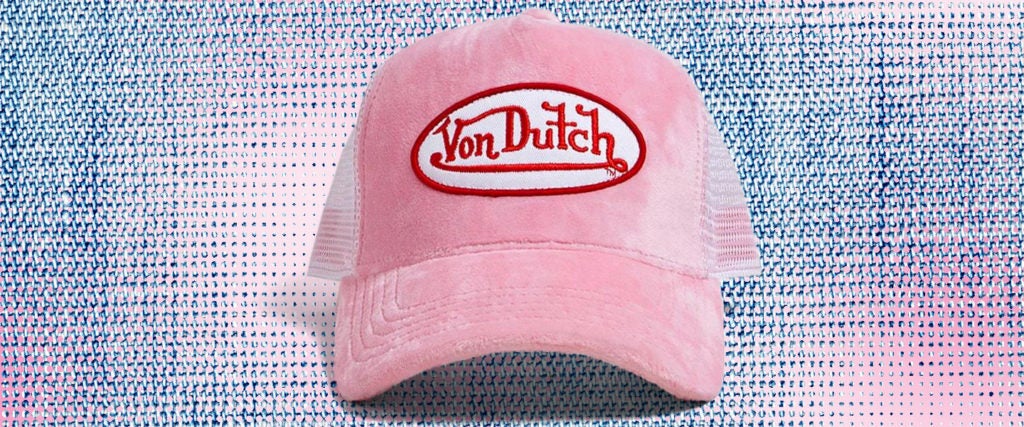Imagine if Nirvana didn’t become a global phenomenon because of their music. Instead, imagine the name became famous because a business mogul approached Kurt Cobain’s daughter seven years after his death, purchased the name “Nirvana” and put it on T-shirts and trucker hats that celebrities like Ashton Kutcher and Paris Hilton would wear around.
That might sound like an odd “what if” scenario, but it’s basically the exact story of how Von Dutch, the brand, became a global phenomenon in the early 2000s. With one highly notable difference: the subsequent airbrush waved over the history of the artist known as “Von Dutch” — a famous pinstriper in L.A. — conveniently blots out a history of overt racism and anti-Semitism.
Von Dutch was the self-anointed nickname of one Kenny Howard. According to Steve Kafka, another famous pinstriper and artist who knew Howard during his life, it means “By German.” “‘Von’ is ‘By’ and ‘Deutsch’ is ‘German,’” Kafka says. “[Howard] was very much enamored by German precision, which, everybody [in the auto industry] is enamored by and impressed by German precision and always has been.”
But for Howard, this bedazzlement over German precision was more than just a fascination with machinery. As reported by the Los Angeles Times in 2018, Howard was a self-admitted “admirer of the Third Reich.” “A letter he wrote about abandoning harsh medical treatment for a fatal illness is blunt: ‘I am not willing to go through it anymore only to emerge in a place full of [N-word], Mexicans and Jews. … I have always been a Nazi and still believe it was the last time the world had a chance of being operated with logic. What a shame so many Americans died and suffered to make the rich richer and save England & France again, or was that still. I hope you lying wimps get swallowed up with your stupidity,’” he wrote.
Kafka — who also notes that Howard signed the letter with “Sieg Heil” — tells me that, despite Howard’s own admission of hating Jews, Mexicans and Black people, he’s leery of “all the derogatory stuff about Von Dutch,” who he says would say all kinds of things simply to make people “go holy crap.” Per Kafka, the self-admitted “racist stuff” was just Howard being a provocateur (an excuse, it should be noted, we’ve seen from alt-right trolls more than a few times of late).
According to Norm Fisk, who directed a documentary about Von Dutch, from what he gathered, Howard was a nasty drunk who was “quite a prejudiced individual.” “I don’t know if you’d call it racist, you might, but he would often elevate the concept of what Hitler did to the Jews, in his mind, as something he viewed as positive,” says Fisk. “Although that became more and more a theme as he grew older and actually sicker — he suffered fairly heavily the last year or so of his life. He lost a tremendous amount of weight. His daughters and his wife said anytime after about 3:30 in the afternoon, they didn’t even try to talk to him.”
Strangely, however, the story of Von Dutch the brand has little to do with Kenny Howard/Von Dutch the person. Howard died in 1992. Four years later, in 1996, his daughters sold the name to Michael Cassel (an entrepreneur) and Robert Vaughn (a clothing designer and entrepreneur) who established Von Dutch Originals in 1999. “[The] Von Dutch store opened on Melrose Avenue a year later,” Forbes reported.
By every account, the sale of the Von Dutch name from Howard’s daughters to Cassel was a complicated transaction. A 2004 report in The Daily Emerald notes, “Ed Boswell, a Los Angeles art collector and publisher, said Cassel, an entrepreneur from Venice, Calif., conned him out of his interests. … Boswell said he has not received any portion of gross sales through Oct. 5, [2004]. He said he made the line what it is today and that Cassel takes full credit for the concept. Boswell said he helped Dutch’s daughters, who sold him out to Cassel.”
Both Kafka and Fisk tell me that Howard’s daughters never really knew what they had. “They took the money, roughly $50,000, and figured, that’s all it’s worth,” says Kafka. “Then they realized the money that they could have made from this. They never would have had to work again. They live in trailers now. One of them is a barmaid.”
In buying the rights to “Von Dutch,” Cassel and Vaughn sought to exploit the imminent explosion of Kustom Kulture (a trend for, essentially, looking like you worked on custom motors in the 1950s). Howard, a pioneer of the Kustom Kulture lifestyle, is arguably the most famous pinstriper of all time: Kafka says that his work in this period was wholly original, using thin lines of paint to create custom designs on motorcycles and hot rods. All of which explains why the name — even in spite of its racist connotations to those who knew better — was invaluable to Cassel and Vaugh’s plans.
In 2001, a few years after the name was purchased outright, Cassel entered a partnership with Tonny Sorensen, the company’s former CEO, who was initially hoping to produce a film about Von Dutch. Sorenson is largely credited with inventing the Von Dutch Trucker hat — the brand’s most iconic contribution to the new Kustom Kulture zeitgeist. “He’s the one that started it, and he’s the one that got it into the hands of Pamela Anderson and all the stars in Hollywood — they had this stuff given to them for free,” says Kafka. “They were wearing it on TV.”
Fortuitously, that same year, the first Fast and Furious movie was released. In the movie, as ProductPlacementBlog.com notes, both Vin Diesel and Paul Walker’s characters wore Von Dutch shirts — a tribute to the Kustom Kulture from which the movie about fast (and presumably furious) cars stems from. At this point, however, the brand was known exclusively in the motorcyclist and racing scene.
But in 2003 came the global explosion. The popularity and success of the brand are generally attributed to “the creativity and work of Christian Audigier and Don ‘Ed’ Hardy: the first is the French fashion designer who left the company in 2004, the latter one of the most famous tattoo artists in the world,” reports NSS Magazine.
Audigier and Hardy are largely credited with helping to get Von Dutch gear into the hands of every socialite and celebrity in the early aughts. “It all started thanks to the greatest Hollywood stars who fell in love, in the true sense of the word, with those trucker caps: they were worn by Britney Spears before her infamous breakdown; Nicole Richie and Tara Reid were wearing them; Paris Hilton and her sister showed off anything branded Von Dutch; Ashton Kutcher practically lived with a Von Dutch hat on his head; Justin Timberlake on the court with NBA cuff and Von Dutch cap; and again Dennis Rodman, Gwen Stefani, Halle Berry and even Madonna often wore one,” the NSS Magazine article continues.
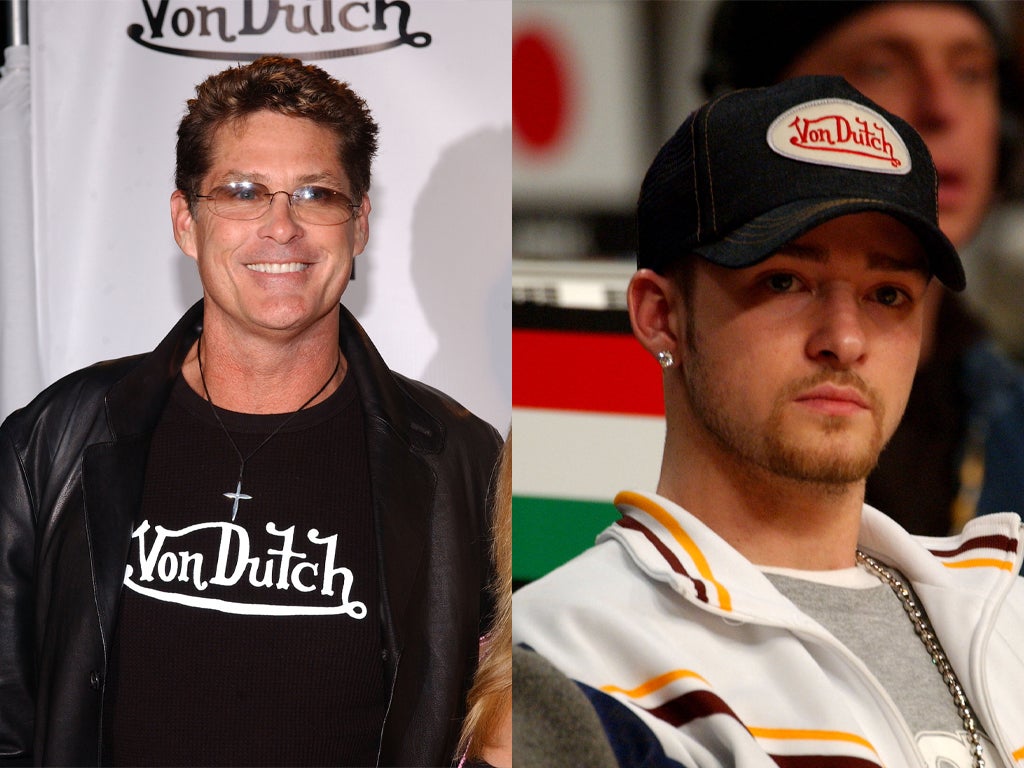
Even during the rise to celebrity it brand, though, there was connective tissue besides just the name Von Dutch that linked the hats and T-shirts to Kenny Howard. Most notably, the brand’s famous symbol — the flying eye — is, according to Kafka, Howard’s rendition of the Mesopotamians’ and the Egyptians’ all-seeing flying eyeball. “He [Howard] elaborated on it, made his crude rendition of what they’d done and he’s credited with designing the first flying eyeball,” says Kafka.
In fact, Kafka tells me that the only reason Von Dutch has the rights to the flying eyeball is because before Howard died, he left a letter to fellow pinstriper Bob Burns bequeathing the rights to his rendition of the symbol. “[Burns] owes it all to Von Dutch,” says Kafka. “He actually sold the rights, that he had no business owning, to someone who then sold it to the Von Dutch corporation for $5,000. They [the company] think they have the rights to the flying eyeball. Well, they do have the rights to the Von Dutch flying eyeball, which is a bastardization of what was designed 4,000 years ago.”
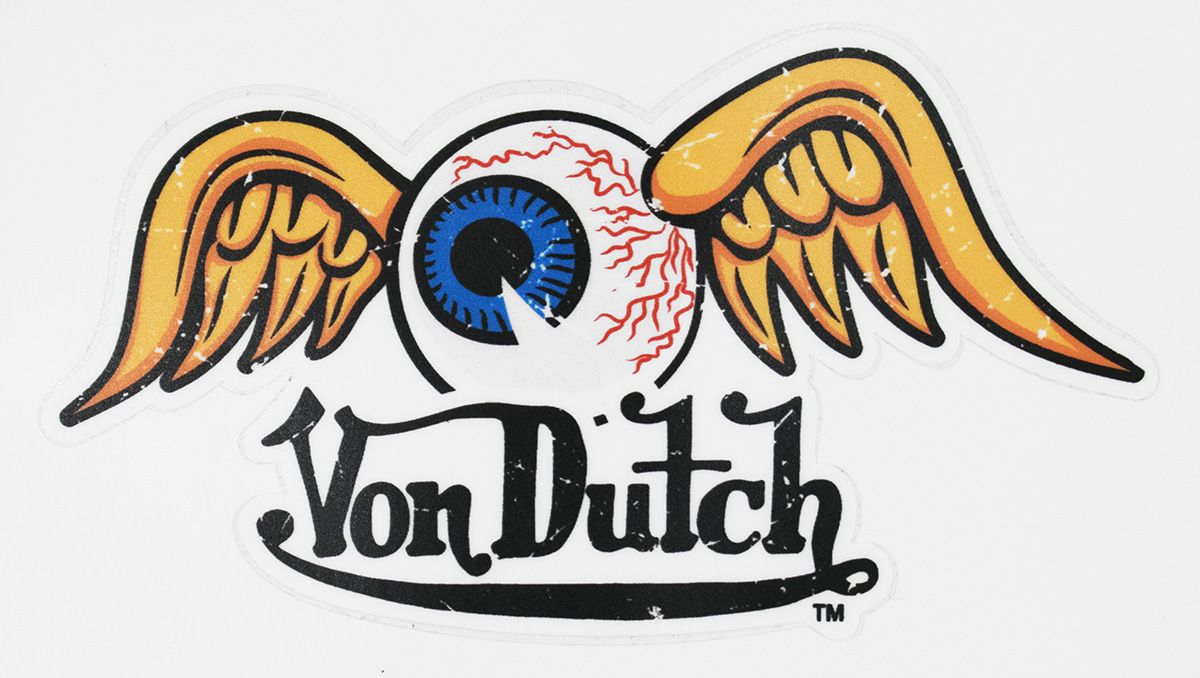
Nonetheless, with its image finely tuned, in 2004, the Von Dutch trucker hat cemented its place in the pantheon of early 2000s iconic apparel when it appeared in an episode of Hilton and Richie’s reality show The Simple Life. “Within hours, the hats were selling on eBay for three times their retail value,” per a 2004 article in the Los Angeles Times, noting that the brand had hit “critical mass.”
The same article clarified that “although the truckers’ hats are the most visible of Von Dutch’s products, Sorensen said the company does more sales volume in jeans, which cost $145 to $320.” A year earlier, in 2003, company sales had reached $33 million. By 2005, Von Dutch was selling three times that amount.
Despite its success — and being anointed “greaser chic” — Von Dutch was primed to soon become a punchline, just as had happened to Oakleys a few years prior. “It’s gotten too popular,” Kasey Rzepecki, 16, a student at Santa Monica High School, told the Los Angeles Times in 2004. “It’s so overexposed.” The teen’s sentiment appeared to be shared by Audigier, who left the company in 2004. Additionally, that same year, T-shirts with “Von Douche,” written in the same familiar font, began to appear.

In the years between 2004 and 2009, Von Dutch would fall into oblivion. The flagship stores in L.A., Miami, New York and Chicago closed their doors. In 2009, Sorensen and Cassel sold the brand to the largest shoe distributor in Europe — French group Royer. “The fellow that is there is the head guy for Von Dutch, a guy named Olivier Mercier,” says Kafka. But according to NSS Magazine, “the beginning of the real rebirth took place in 2016 when, in a completely unexpected way, Kylie Jenner started a sort of ‘under track’ campaign.”
A report in Style Caster notes that Jenner began posting pictures of herself with the iconic Von Dutch trucker hat. A few days later, Bustle ran a headline: “Where To Buy Kylie Jenner’s Von Dutch Jacket, Because She’s Bringing Back the ‘00s.” Two days after that, Glamour ran a similar headline, suggesting that a version of the Von Dutch jacket, as seen on Jenner, is available “on Overstock that will take you from normal to Kardashian for under $60.” Overnight, it seemed as though the brand was embarking upon a resurgence.
Most recently, Fashionista reported that Ed Goldman, Von Dutch’s general manager, “credits the brand’s most recent explosion onto the fashion scene with the strategic choice to relocate its offices from Corona, California, to the heart of L.A.” “There have also been changes to how the company is run: In 2019, Von Dutch decided to operate corporately, instead of through a licensee structure, allowing it to bring control over the brand’s distribution and creative direction back in-house.”
More essentially, though, Von Dutch’s secret to success is simply doing what they’ve always done: Placing their products in the hands of some of the most influential celebrities in the world, all the while airbrushing their namesake’s racist past.
When reached for comment about Howard, a Von Dutch representative tells me by phone that he had “nothing to do with the brand.” Yet when I first contacted them by email, their website’s history section very much highlighted him as an inspiration. “Kenny Howard aka Von Dutch, was an American legend and considered the ‘godfather of modern-day pinstriping’ — customizing cars, motorcycles and apparel with his signature art, style and graphics,” it read. “Today, his eponymous clothing brand continues his legacy and is currently worn by the biggest in music and Hollywood.” (This section had been removed from the site by the time of our call.)
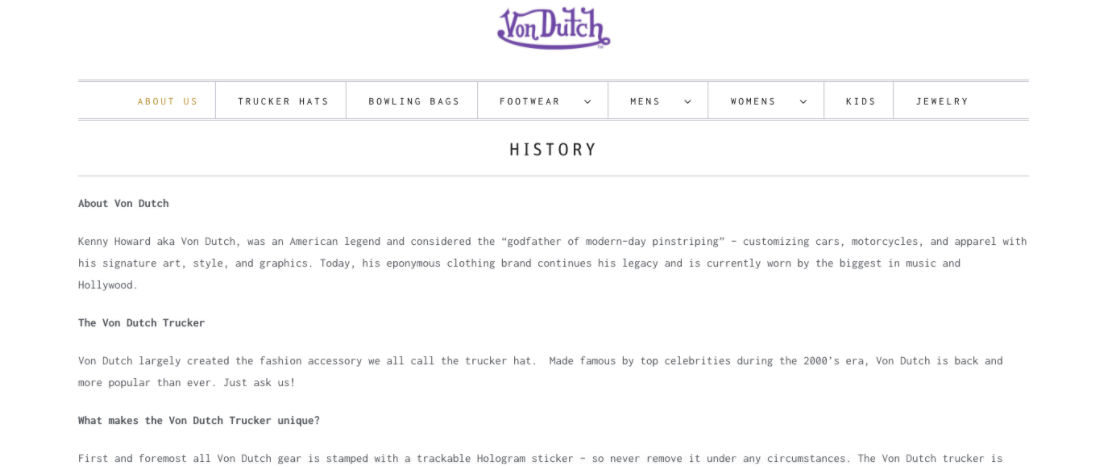
On the day following our phone call, the website credited “Christian Audejar” (apparently a misspelling of Christian Audigier) with creating the brand in the early 2000s.
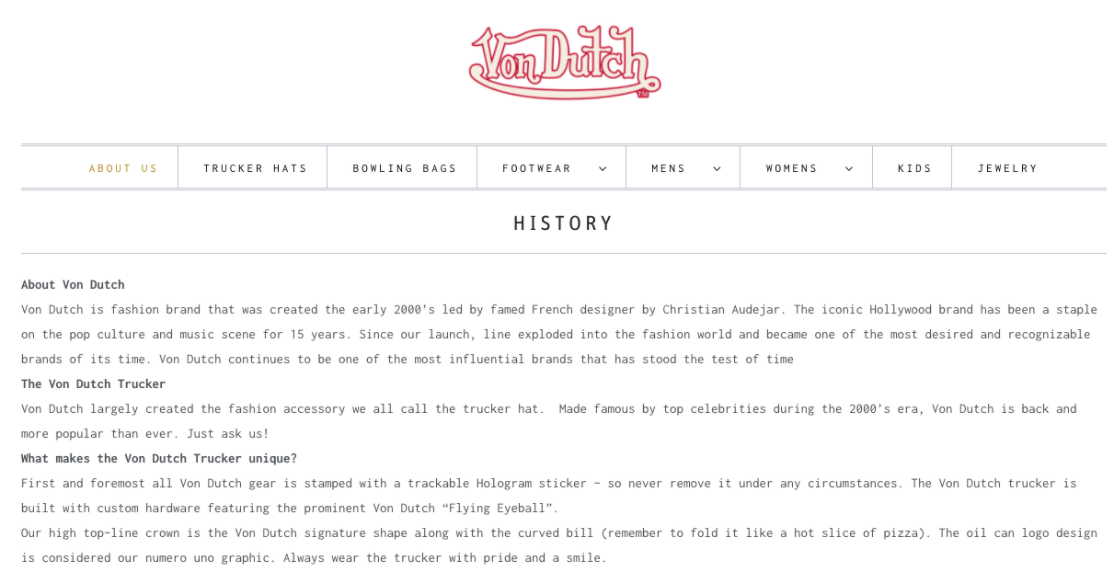
It has since been updated at least one more time:
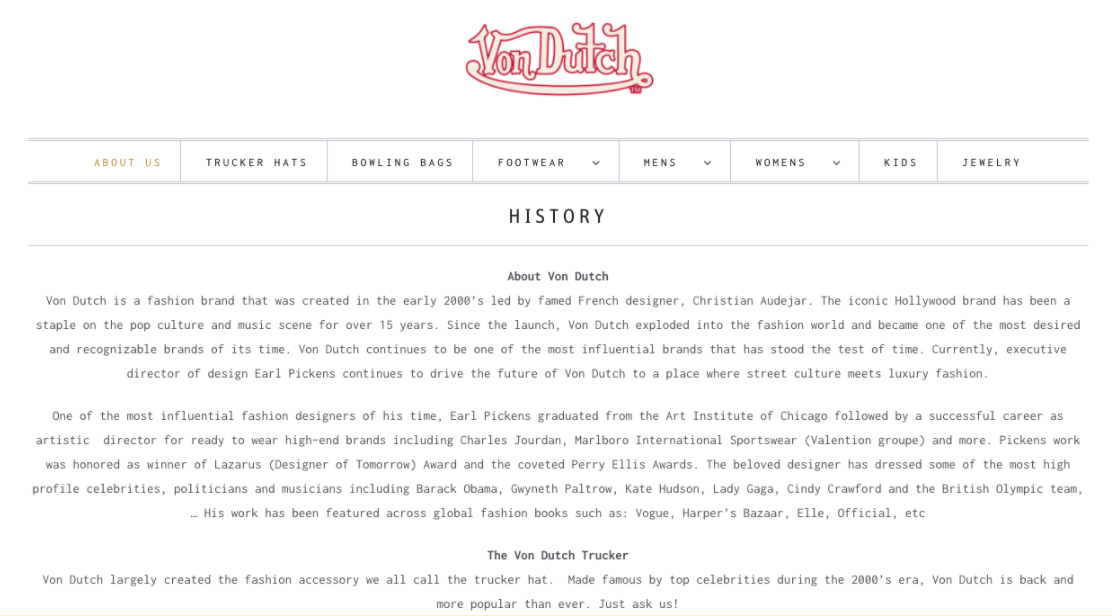
Howard, though, still remains visible on both the Von Dutch Twitter and Instagram accounts.
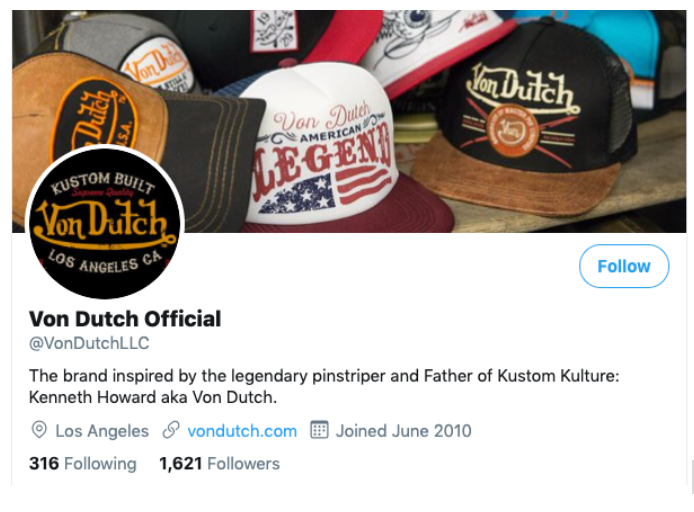
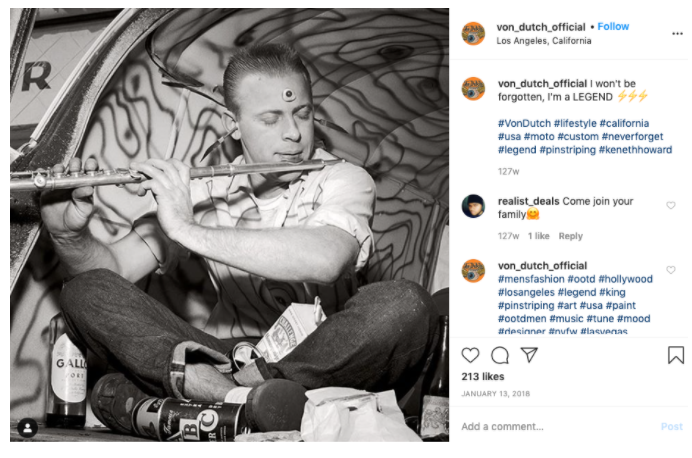
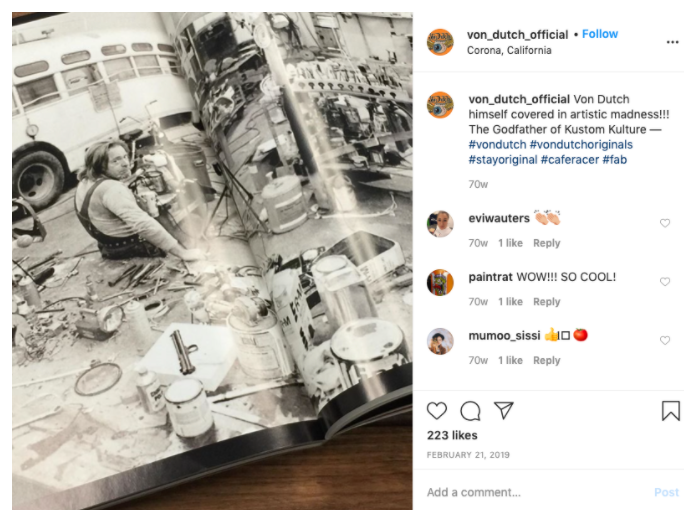
Of course, the brand has come a long way since its birth. The biggest irony, in fact, is that most everyone who knew Howard suggests that he would have hated what the brand became (“‘If Von Dutch only knew, oh, he’d kill ‘em,’ said Skratch, who builds and paints 1950s-style hot rods and custom cars. ‘To know that a Russian Jew stole the name from his daughter, he’d flip. Oh yeah, full-on,’” OC Weekly reported back in 2004). And not just because it’s so often worn by the same people he felt were “ruining the world,” but also because Howard’s professional legacy — pinstriping — had nothing whatsoever to do with fashion.
Perhaps, then, the real legacy of Von Dutch, both the brand and the man, is simply the same depressing lesson we’ve seen over and over again: That any sordid history can be glossed over with the right celebrity endorsement.
